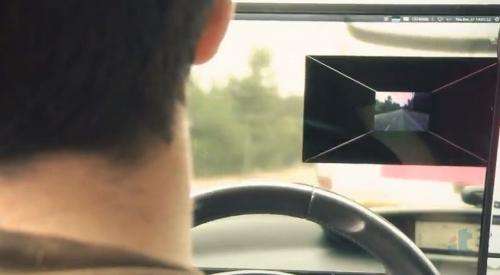October 19, 2013 weblog
University team has AR See-Through System for safe driving (w/ Video)

(Phys.org) —University of Porto in Portugal researchers have come up with a See-Through System (STS) designed to see through vehicles, making view-blocking vehicles transparent. A lightweight heads-up display is used to look through a truck, for example, ahead. The idea is to support a driver who is stuck behind a large, slow-moving vehicle on the highway and has no way to check if it is safe or not to pass. According to a New Scientist report on the system, the image has a delay of 200 milliseconds, and it shows an oncoming car to be ten meters further away than it actually is, if both it and the driver's car are moving at 90 kilometers per hour.
Michel Ferreira and his colleagues at the University of Porto in Portugal developed the See-Through System. Ferreira is also founder of a technology-based company specialized in the "optimization of vehicular mobility," called Geolink. Ferreira has stated that he is not only interested in "Intelligent Transportation Systems" (ITS) but in what he terms "Cooperative ITS," where inter-vehicle communication plays an important role.
In a scenario involving the See Through System, large vehicles drive with a forward-facing webcam on their windshield. Cars have a transparent LCD screen built into their windshield. The driver is able to see what the road in front of the blocking vehicle looks like, in the position that the vehicle occupies on the road.
The system has been tested in a driving simulator, and on the road. Their work was presented at The International Symposium on Mixed and Augmented Reality in Australia earlier this month. Actually, this is an initiative that has been ongoing for several years. In 2010, the paper, "The See-Through System: A VANET-Enabled Assistant for Overtaking Maneuvers " was presented at an IEEE symposium. The authors said that thus far the "results are promising, since the use of the 802.11p standard wireless communication protocol allows a vehicle-to-vehicle connection without significant delay and the totality of the participants regarded the information provided by the STS as useful."
The term VANET stands for Vehicular Ad Hoc Networks, a key focal point in Ferreir'a research."Vehicular Networks are a particular case of networks where the geographical awareness of nodes is crucial in the design of protocols and applications," he said. "A major goal in my research is the efficient design of large-scale distributed systems that use infrastructureless communication to self-organize, based on spatial reasoning."
In that 2010 paper, the authors noted that the STS system is based on the following assumptions: Equipped vehicles have windshield-installed cameras, connected to an on-board computer that can compress video, recognize traffic signs and support inter-vehicle communication protocols; equipped vehicles have GPS, and DSRC radios; equipped vision-obstructing/long vehicles display a rear sign mentioning "STS Enabled" (a VANET enhancement over the typical "Long Vehicle" sign); and equipped overtaking vehicles have a screen on the dashboard where the video streaming can be visualized.
More information:
Research paper: www.it.pt/papconf_pdf_p.asp?ID … onference=10281&id=3
ismar.vgtc.org/
www.newscientist.com/article/m … cars-seethrough.html
www.dcc.fc.up.pt/~michel/
© 2013 Phys.org

















